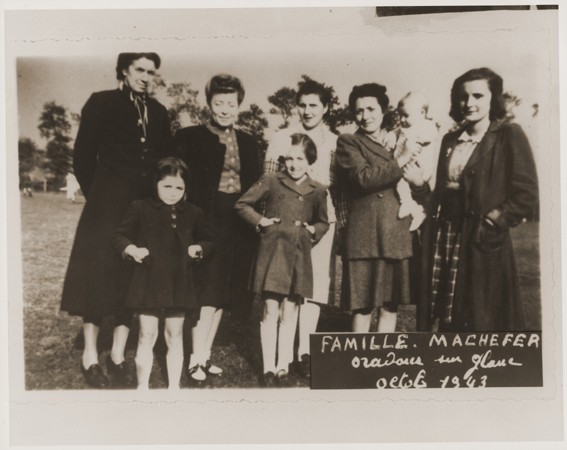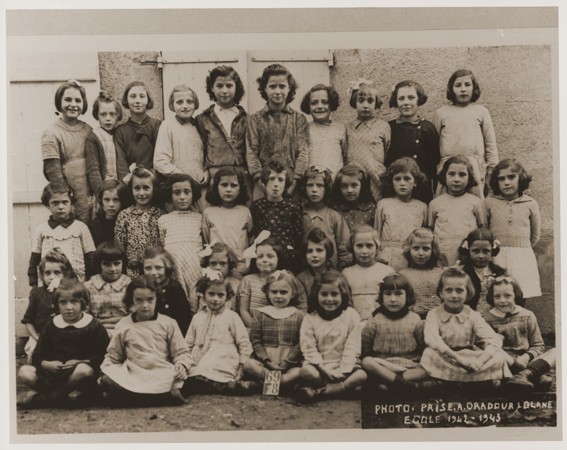
Oradour-sur-Glane
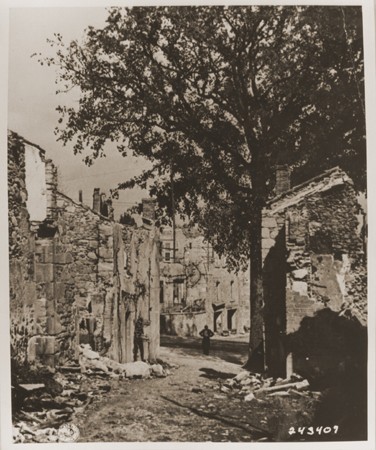
Oradour-sur-Glane was a small farming village of around 350 inhabitants, located near Clermont-Ferrand, some 15 miles west-north-west of Limoges. During World War II, it was located in the German-occupied zone of France. On June 10, 1944, troops of the 2nd Waffen-SS Panzer Division (armored division), Das Reich, massacred 642 people, almost the entire population, and then destroyed the village. After the war, Oradour-sur-Glane rivaled Lidice as an iconic symbol of German crimes against civilians in occupied Europe.
German occupation authorities in France
During World War II, German occupation authorities in France reacted with increasing brutality to organized attacks on German soldiers, headquarters, and property by the resistance movement, more commonly known as the maquis or Résistance. The German military killed hostages and incarcerated in concentration camps real or perceived supporters or sympathizers of the resistance movement. In general, German anti-partisan measures in France never attained the level of violence or the numbers of civilian deaths as those implemented in eastern and southeastern Europe, especially in Serbia, Greece, and the Soviet Union.
Before but especially following the Allied landings on the Normandy coast on June 6, 1944, the French resistance movement intensified efforts to disrupt German communications and supply lines. German military commanders, particularly those who had seen service on the eastern front and whose response to partisan activity had been conditioned by the extraordinary brutality of anti-partisan measures there, radicalized and intensified responses to real and perceived resistance activity.
On June 8, 1944, two days after the Allied landing, the German Army Commander-in-Chief for the West, Field Marshal Gerd von Rundstedt, issued orders to “crush” the resistance “with swift and ruthless initiative,” and express the “expectation that the major operation against the gangs [i.e., partisans] in Southern France will be carried out with the greatest severity and without leniency.” General Karl-Heinrich von Stülpnagel, the Military Commander in France, ordered the redeployment of a number of units stationed throughout France to reinforce the Normandy front and to crush partisan activity behind the German lines. Among the units redeployed to Normandy was the 2nd Waffen-SS Panzer Division Das Reich, which had arrived as a reserve unit in the southern French town of Montauban in January 1944.
Das Reich had seen two years of combat duty, including numerous anti-partisan actions on the eastern front, before its transfer to France. Its commander, SS-Major General Heinz Bernhard Lammerding, had served from July 1943 to January 1944 as the chief of staff for SS-General Erich von dem Bach-Zelewski, whom Himmler had appointed to command and coordinate anti-partisan operations behind German lines in the occupied Soviet Union. In this capacity, Lammerding had ordered several retaliation actions against Soviet civilians for real or perceived partisan activities or “sympathies.” Such operations involved the murder of tens of thousands of civilians, many of whom had had nothing to do with the partisans, and the torching of dozens of villages.
As the 2nd SS Division redeployed to Normandy, French resistance fighters harassed it. On June 9, 1944, Lammerding issued orders for the division to “cleanse” the area around Clermont-Ferrand of partisans. That same day, members of the division had displayed what “cleansing” of partisans would mean. In retaliation for an attack, soldiers of Das Reich hanged 99 male inhabitants of the village Tulle, near Limoges.
The next day, June 10, 1944, soldiers of the 3rd Company, 1st Battalion, 4th SS-Panzergrenadier Regiment (motorized infantry) Der Führer, a subordinate unit of the 2nd SS Panzer Division since April 1944, advanced to the village of Oradour-sur-Glane. Led by the commander of the 1st Battalion, SS Major Adolf Diekmann, the Waffen-SS troops surrounded the village at midday. At that point in time, the village population had almost doubled to about 650 people, swelled by refugees, including some Jewish refugees, from other parts of France.
Massacre and destruction of Oradour-sur-Glane
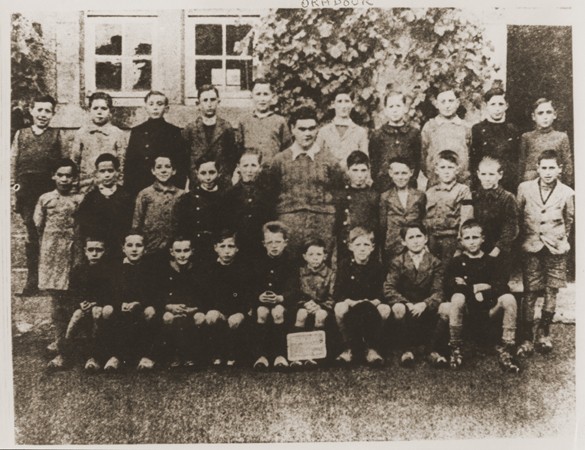
The SS soldiers rounded up the entire population and concentrated them on the market square. Thereafter they separated the villagers by gender. Members of the 1st and 2nd platoons took the 197 men to several barns on the edge of town and locked them in. The 3rd platoon locked up 240 women and 205 children in the village church. Then the SS men set fire to the barns and threw grenades through the windows of the church, shooting those who sought to escape the flames.
After 642 inhabitants, including seven Jewish refugees, were dead, the company looted the empty dwellings and then burned the village to the ground. At about 8:00 p.m. on the evening of June 10, the SS men withdrew from the smoking ruins. Only seven villagers survived the massacre: six men and a woman, all of them more or less severely injured. About fifteen other inhabitants of the village were able to escape the Germans before the massacre started or evade the roundup by hiding.
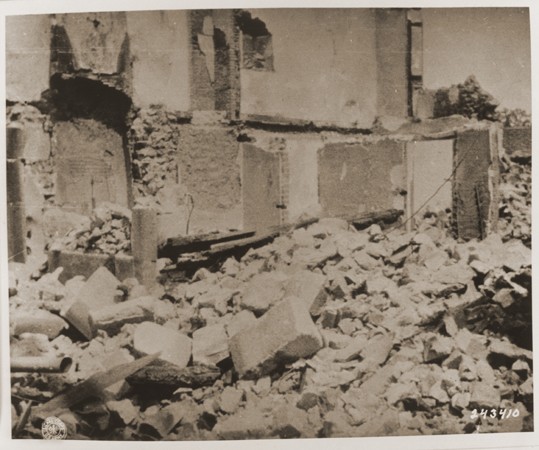
After the massacre
The Oradour-sur-Glane massacre received significant contemporaneous attention, requiring the German Army command to search for an explanation and the officers of the Das Reich to find one.
On the evening of June 10, after the troops left Oradour-sur-Glane, Diekmann gathered his officers and non-commissioned officers and ordered them not to speak about the killings. He told them that, if asked, they should say that insurgents attacked the division in the village and the villagers were killed during the firefight. The German Army High Command then offered this explanation to the State Secretary in the Vichy Ministry of Defense, General Eugène Bridoux, after Vichy diplomats had sent a formal protest note that contained an accurate account of the events of June 10. The German explanation stated that:
- The men of the village died during the fight
- The fight had been initiated from the village
- The women and children had taken refuge inside the church and died as the result of an explosion from an nearby insurgent ammunition supply dump that ignited the inside of the church.
To quell increasing public outrage and to try to keep the Vichy government from going over to the Allies, the German Army Commander-in-Chief in the West ordered a criminal investigation of the massacre. Since the SS was under a different jurisdiction than the German army, SS judge Major Detlef Okrent conducted the investigation, in which he relied significantly on the testimony of SS Captain Otto Kahn. Okrent stayed the proceeding in January 1945, concluding that “military concerns justified the retaliation.
Postwar
After the war, the massacre in Oradour-sur-Glane also received a great deal of attention. In 1946, the French government declared the site to be a national memorial site and mandated its conservation. The French prosecution team presented documentation of the killings at the International Military Tribunal in Nuremberg in 1946.
Why Diekmann and his superiors chose Oradour-sur-Glane and who gave the order to kill the inhabitants remains disputed. Neither the International Military Tribunal nor the French authorities at proceedings in Bordeaux in 1953 produced conclusive evidence either linking Oradour-sur-Glane with the French resistance or determining who ordered the massacre. When authorities in the Democratic German Republic prosecuted Heinz Barth, an NCO who participated in the Oradour-sur-Glane massacre, in 1981, they too could not reach a conclusive answer to these questions.
The evidence presented at the trials and in West German investigations of officers of Das Reich generated a number of theories as to why the SS targeted Oradour-sur-Glane. The most common explanation is that Lammerding and Diekmann received intelligence from SS Major Karl Gerlach (whom insurgents had kidnapped, but who had escaped) that the villagers were assisting the resistance. A variation of this theory is that French collaborators misled the Germans, perhaps deliberately, into believing that French insurgents were holding another kidnapped German officer, SS Major Helmut Kämpfe, in Oradour-sur-Glane, and that they planned to kill him. This explanation is based on flimsy evidence and flawed logic, for there is no indication that the Germans searched Oradour-sur-Glane for Kämpfe. Nor did the soldiers of Das Reich continue the search after the massacre, either in Oradour-sur-Glane or anywhere else. Moreover, survivors stated that one of the German officers, later identified as SS Captain Otto Kahn, never mentioned Kämpfe, but did inform the villagers that the homes would be searched for weapons and ammunition.
Other explanations seem even less convincing. There is no indication that the Germans ever received intelligence that Oradour was the site of an insurgent headquarters, as SS Major Otto Weidigner, an officer of Das Reich who had not been involved in the massacre, claimed after the war. There is no information in the German military records that insurgents attacked German troops near Oradour. A war diary entry for the Military Commander in France for June 14 generated the theory that the troops of the 2nd Waffen SS Panzer Division had confused Oradour-sur-Glane with Oradour-sur-Vayres, a village about 15 miles to the southeast. This theory is undermined by the absence of any reference to an insurgent attack on the Germans near Oradour-sur-Vayres during this time period.
For all the attention the killings have received, few of the SS men responsible for the massacre ever stood trial. Diekmann fell in combat three weeks after the massacre. German authorities refused to extradite Lammerding to France even though he was convicted and sentenced to death in absentia by the court in Bordeaux in 1953. German lawyers claimed that the German constitution prohibited the extradition of German citizens. The state prosecutor’s office in Frankfurt reopened the Lammerding case in 1961, but stayed the proceedings on grounds of insufficient evidence in 1964. Lammerding died in West Germany in 1971.
In 1953, a French military court in Bordeaux prosecuted 21 former members of the 2nd SS Division for crimes committed at Oradour-sur-Glane and Tulle. Fourteen of the defendants were ethnic Germans from Alsace. The court convicted 20 of the defendants; it sentenced two to death and the rest to prison terms between five and 20 years. Amnesties and pardons, however, freed all of the convicts, including the two sentenced to death, within five years of the trial.
In 1981, authorities in the German Democratic Republic arrested and prosecuted Heinz Barth, a former SS Sergeant and platoon commander whose soldiers were among those who shot the men of Oradour-sur-Glane. An East Berlin court sentenced Barth to life in prison. Released in 1997, Barth died in 2007 at the age of 86.
